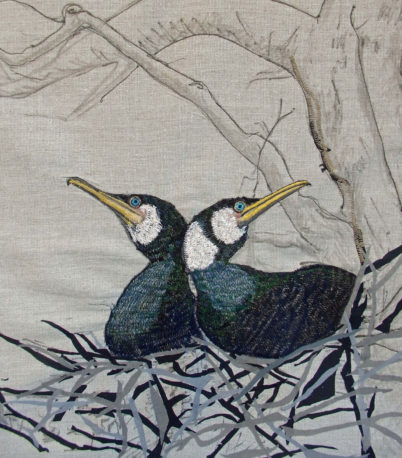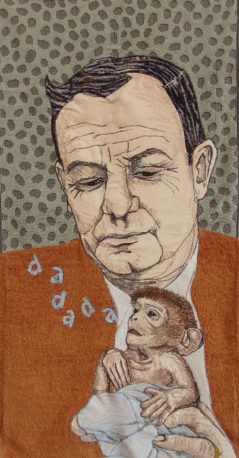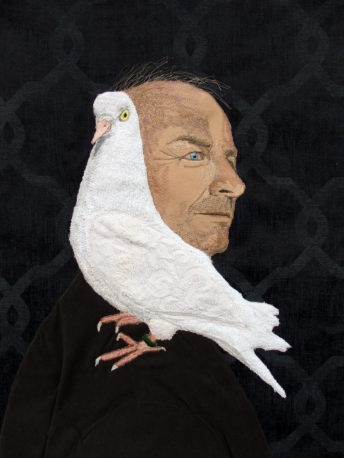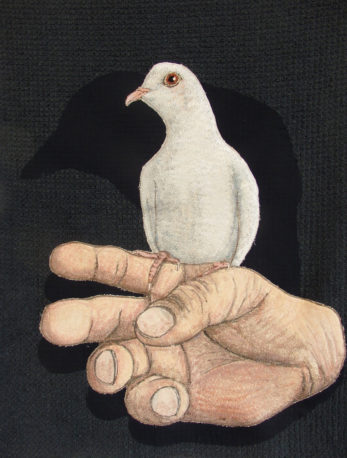World Fine Art Professionals and their Key-Pieces, 464 - Petra van der Steen
World Fine Art Professionals and their Key-Pieces, 464 – Petra van der Steen
Petra van der Steen was one of the six artists at the Pop up Bos exhibition in Kunstruim in Amsterdam last January. I saw beautiful embroidered works by her of various birds, including a jackdaw, a duck, an albatross and a dove.
Petra is an artist who works with textiles under the heading ‘critical embroidery’. Her work can be divided into visual work and text work. In the sculptures you see a lot of nature: birds, small animals such as monkeys and people – a person is also an animal, right? The images are very accurate and very similar. The text work is hilarious. Simple, frequently used phrases, words and sayings have been recorded. ‘Very important’, ‘You can’t do anything about it’, ‘It could be worse’, ‘Everything is getting worse’. These are those meaningless stop phrases to keep conversation going.
Text embroidery
I see both types of work on the wall in her studio in a converted – formerly squatted – warehouse on the river IJ, where many artists work. When she looks outside she can see the ships sailing past.
These text embroideries are statements or individual words that stick in your head; often platitudes and obsessive thoughts, she says. “I started embroidering texts on underwear, old-fashioned women’s underwear. Phrases like ‘wait until you have children of your own’ or ‘you should have seen me when I was young’ came from my mother. These were statements that really irritated me, but I couldn’t let them go. By embroidering them on that ridiculously large underwear it gave it something humorous and I could let it go.”
As a child, Petra van der Steen, who grew up in Central Limburg, spent a lot of time drawing and embroidering. “I first did that embroidery with cross stitches on self-designed patterns. Later I embroidered my first denim jacket completely with psychedelic and political images in a free stitch.”
In the mid-1980s she went to ‘De Witte Lelie’, a teacher training course for drawing and crafts in Amsterdam. “That was a good education at the time, in addition to thorough knowledge of painting and craft techniques, you also received a good foundation in art history and art appreciation.” She then went to the Gerrit Rietveld Academy, where she graduated in the early 1990s.
Granny underpanties
“I graduated with photo objects. As a novice artist, I started with macro photos of skin and scars (stitching!) that I combined with other materials including wood, turning them into spatial objects. I explored the possibilities of photography in a spatial context. After a while I started connecting those photos by sewing them together and stuffing them, creating a sort of cushion – I was looking for a certain softness. There the seed was sown for the switch to textiles. As I became further separated – also in time – from the academy and the ideas in vogue there about how art should be – innovative and abstract, the thought arose: ‘Why don’t I just start working with textiles again?’ “
She did. The year was 2000. She started with old-fashioned granny under-panties. Underwear is like a second skin, she says. “I gave a second life to materials in which someone had ‘lived’, clothing from someone who is no longer there. Things really took off. It gave freedom. I am very much in favor of recycling. I still do that.” When her father died, she made a hand-embroidered portrait of him on a bath towel he used.
Our relationship with animals
In terms of themes, there has been development in her work, but the basic tone remains the same: nature is the basis. Since childhood, she has been concerned with our relationship with animals. “We really lived outside in Limburg. From school we went into the fields and the woods, rescuing injured birds. Grandpa told all kinds of things about birds and plants. He was the kind of man with all of Jac. P. Thijsse books in the bookcase.”
As a teenager, she saw Bert Haanstra’s film ‘Bij de beesten af’, where she saw young rhesus monkeys with a surrogate mother. Those images made an unforgettable impression. When she looked into this later, she came across the research of Harry Harlow, an American ethologist/psychologist who conducted research into mother-child bonding in baby rhesus monkeys isolated from their mother. He thus demonstrated the importance of physical contact and attention to social and cognitive development. Harlow’s isolation experiments, however, were controversial because they were unnecessarily cruel and continued for years even though the results of the research had long been known.
She embroidered a portrait of ‘Daddy’ Harlow with a rhesus monkey in his hands. It was the beginning of a series of male scientists/researchers and their (test) animals. In these works there is a tension between the vulnerability of the animal and the omnipotence of the researcher.
Keywork
Her key work is the portrait of her father, she says. To cope with his death, she embroidered his head surrounded by a lace decoration on a bath towel he used. It took her several months, it was a contemplative experience. “Until then I had made work at a distance. It became clear to me that I had to do things that were close to me. Only there is the involvement optimal and it even feels like a necessary thing.”
After a trip to South Korea in 1999, this feeling was reinforced. “I was fascinated by Korean embroidery. Very refined and full of color. There in the mountains I had enough time to reflect on my life and work. I decided that from now on I wanted to work more intuitively and would care less about whether what I did was innovative or relevant to the art world.”
At that time she saw an exhibition in Museum Bronbeek about objects made by prisoners in Japanese internment camps in the Dutch East Indies during the Second World War. In the women’s camp, embroidery was made from scraps of fabric and threads pulled from torn garments, depicting the harsh camp life. “It was all very illegal and yet they made it. Apparently people feel the need to create even in the most dire circumstances. It seems like a survival mechanism.”
Petra picked up her old love again. It started with embroidered tattoos on used underwear.
Collage works 2023-2024
After many exhibitions where her birds in particular were exhibited, she thought ‘I’m starting to work on a routine, time for something different, let me be guided by the material and see what comes out of it?’ She threw boxes of leftover textiles on the floor and then – after sorting – she started making collage works. “I made them in the same size. For example, I used parts of Japanese obi (kimono straps) and embroidered Chinese fabrics.” Alienating works were created with strange titles such as ‘Chromosome boat’ and ‘Dysfunctional landscape on Monday’, which she successfully exhibited in the LOSDOK exhibition space – in her building.
She feels that experimenting with collage appliqué has loosened up her work and she will continue with it for the time being.
Petra also guides artists with disabilities. In Utrecht she works at Ateliers De Wijde Doelen; a studio where graphics and ceramics are made by so-called outsider art artists. Their works were shown in No Limits! Art Castle in Sexyland Gallery and The Museum of the Spirit (Museum van de Geest). Artist Jan Hoek and his team have No Limits! set up and play an important role in the connection between the different art worlds. “It is fantastic that art by artists who usually remain on the margins is now being seen more and that I can contribute to this. It is liberating and inspiring to work with this target group.”
What is her experience of art life?
“That is very diverse. One of my favorite things is making connections with other artists, coming up with projects, and then trying to find a place for them. This has happened in the past with artist initiatives such as W139, but also with Arti et Amicitiae and LOSDOK. If you rent a pop-up space, for example, you have complete control over everything. It is also nice to exhibit in public spaces such as hospitals or care centers. This means you reach a broader and sensitive audience. Of course, I have also exhibited at galleries, but I don’t like to be tied to a place with the associated obligations, I like my freedom.”
Finally, what is her philosophy?
“Don’t be limited by dogmas about what good art is. I initially loved the work of an artist like Anselm Kiefer. Later I thought: it’s so megalomaniac. So big, bigger, biggest. It’s muscle work. A work of art does not have to be large, quality can also be very small.” She points to a canvas on the wall that says ‘Keep it simple’.
Images
1) Cormorants, 2024, 2) albatross, 3) anchor dad, 4)daddy harlow, 5) deaddad2, 6) the chairman, 2016, 7) hand bird xxs2, 8) portrait Petra , 9) shadow dove, 10) karma
https://petravandersteen.nl/
https://www.instagram.com/kritisch_borduurwerk/
https://inzaken.eu/2024/04/28/kritisch-borduurwerk-van-petra-van-der-steen/
Disclaimer: The views, opinions and positions expressed within this guest article are those of the author Walter van Teeffelen alone and do not represent those of the Marbella Marbella website. The accuracy, completeness and validity of any statements made within this article are not guaranteed. We accept no liability for any errors, omissions or representations. The copyright of this content belongs to Walter van Teeffelen and any liability with regards to infringement of intellectual property rights remains with the author.

























The opinions expressed by individual commentators and contributors do not necessarily constitute this website's position on the particular topic.